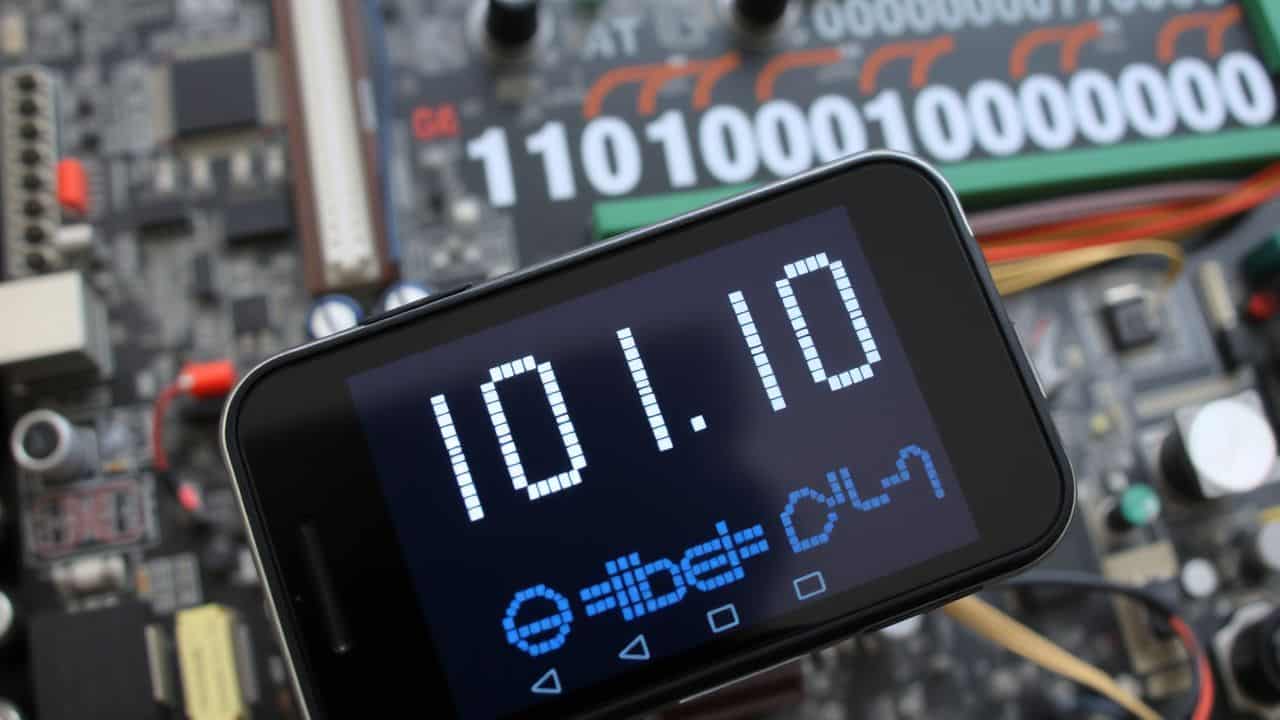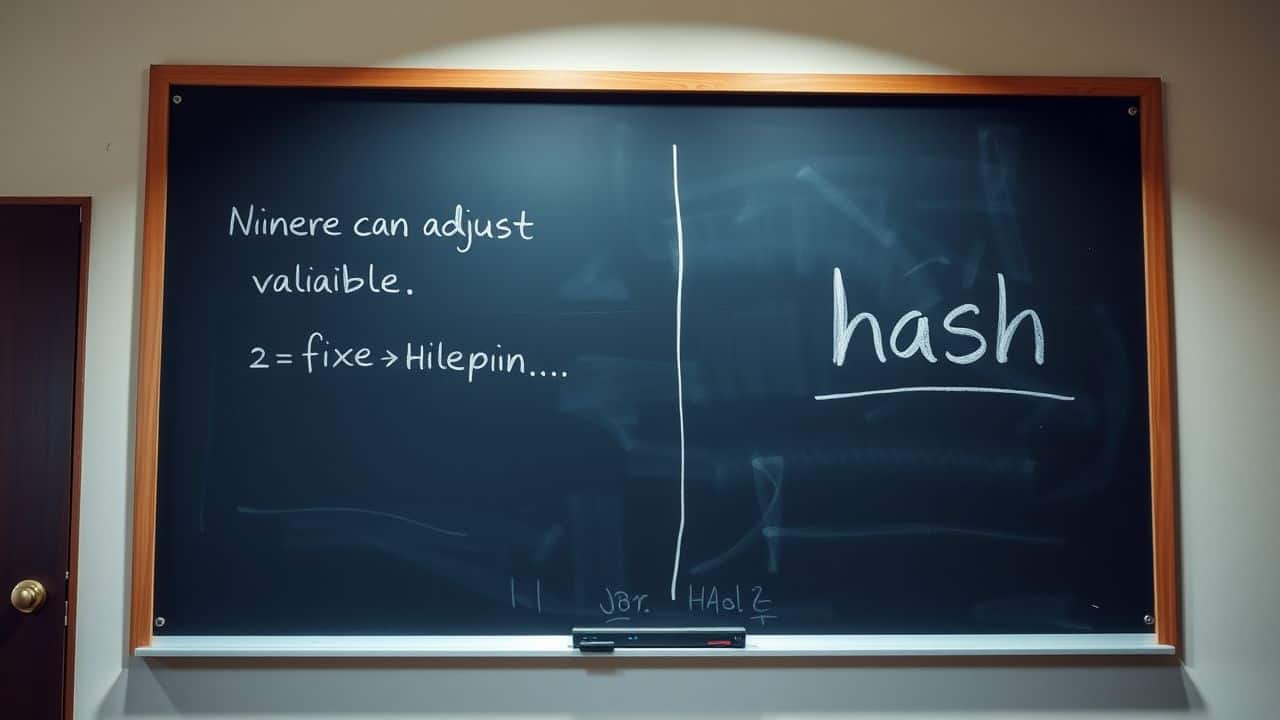Ever felt lost in the maze of blockchain tech? You’re not alone. Nonces play a key role in this digital world. This guide will break down what a nonce is in blockchain, minus the jargon.
Get ready to crack the code!
Key Takeaways
A nonce is a 32-bit number used in blockchain mining to find a valid hash that meets network rules.
Nonces prevent double-spending and replay attacks by giving each transaction a unique identifier.
In Bitcoin, miners tried billions of nonces to find the right one for block 841,948, which had a nonce of 1,614,498,317.
Nonces play a key role in Proof-of-Work systems by forcing miners to use real computing power to validate blocks.
Reusing or predicting nonces can lead to security risks, so strong random number generation is crucial for blockchain safety.
Table of Contents
Explaining Nonce in Blockchain

Now that we’ve covered the basics, let’s dig into the nitty-gritty of nonces in blockchain. A nonce is a 32-bit number that plays a key role in the mining process. It’s like a secret code miners use to solve a puzzle.
Miners change this number over and over until they find a hash that fits the network’s rules. This process is crucial for adding new blocks to the chain and keeping the system secure.

Think of a nonce as a lucky charm for miners. They need it to create a valid block and earn rewards. Without nonces, mining would be impossible. The nonce works with other data in the block header to create a unique hash.
A nonce is the blockchain’s way of saying ‘try, try again’ until you succeed.
This hash must meet certain criteria set by the network. It’s a game of trial and error, and the first miner to find a valid nonce wins. With mining activity impacting ETH price prediction, many traders closely watch these processes. By the way, if you’re curious about the price of Ethereum, you can check it out anytime.
Functions of a Nonce in Blockchain

Nonces play a crucial role in blockchain systems. They act as a key part of the mining process, helping to create new blocks. Miners tweak the nonce to find a hash that fits the network’s rules.
This process, known as proof of work, keeps the blockchain secure and fair.
But nonces do more than just help with mining. They also stop people from using the same transaction twice. In networks like Ethereum, each transaction gets a unique nonce. This stops bad actors from copying old transactions to steal funds.
Nonces also help keep track of how many transactions an account has made. This info is vital for the smooth running of the blockchain. Next, let’s look at the different types of nonces used in blockchain systems.
Categories of Nonces in Blockchain

Nonces in blockchain come in different types, each with its own role. Want to know more about these digital numbers? Keep reading!
Nonces in Mining

Miners play a crucial role in blockchain networks. They use special computers to solve complex math puzzles. These puzzles involve finding a special number called a nonce. The nonce is a 32-bit number in the block header.
Miners test millions of nonces every second to find the right one.
Finding the correct nonce is like hitting the jackpot. It’s not easy. Miners often try billions of nonces before succeeding. For example, Block 841,948 had a nonce of 1,614,498,317.
That’s a lot of tries! If a nonce doesn’t work, miners increase it by one and try again. This process repeats until they find the golden nonce or reach the max of 4.29 billion.
Mining is like a high-stakes digital lottery, where the prize is securing the blockchain.
Nonces in Transactions

Nonces play a key role in blockchain transactions. They act as unique identifiers for each transaction. In Ethereum, nonces stop replay attacks. These attacks try to use the same transaction twice.
The nonce increases by one for each new transaction from an account. This system keeps track of the order and number of transactions.
Blockchain networks use nonces to verify transactions. Each transaction includes a nonce value. This value helps confirm that the transaction is new and valid. Without nonces, bad actors could copy old transactions and reuse them.
This would cause chaos in the system. Nonces work with other parts of the blockchain, like Layer 2 solutions, to boost security.
Let’s explore how nonces function in mining next.
Nonces in Accounts
Nonces play a key role in blockchain accounts. They act as unique counters for each account, tracking the number of transactions sent. Every time an account sends a transaction, its nonce goes up by one.
This system stops the same transaction from being processed twice. It also keeps transactions in order, which is vital for the blockchain’s smooth running.
Account nonces differ from mining nonces. They focus on transaction order and security, not block creation. Without them, attackers could replay old transactions or mess up the order of new ones.
This would cause chaos in the blockchain network. Next, let’s look at how nonces contribute to the Bitcoin blockchain.
Nonce Contribution in Bitcoin Blockchain

Nonces play a key role in Bitcoin’s mining process. Miners tweak the nonce to find a hash that meets the network’s target. This trial-and-error method is central to proof-of-work. For example, block 841,948 used a nonce of 1,614,498,317 to create a valid hash.
The next block, 841,949, needed a different nonce: 4,218,083,700. These numbers show how much work goes into mining each block.
Bitcoin’s difficulty changes about every two weeks. This keeps block times steady as more miners join. Miners must try billions of nonces to find one that works. It’s like solving a giant puzzle where the rules keep changing.
As a miner myself, I’ve seen firsthand how tricky it can be to find that golden nonce. But when you do, it’s a rush!
Nonce in Proof-of-Work Protocol

Proof-of-Work (PoW) systems like Bitcoin rely on nonces to secure the network. Miners use these random numbers to solve complex math puzzles. They add a nonce to the block header and run it through a hash function.
The goal? To find a hash that meets the network’s difficulty target. This process is tough and takes lots of tries. Miners keep changing the nonce until they hit the jackpot. It’s like playing a high-stakes lottery where the odds are always changing.
The nonce plays a key role in making PoW systems hard to cheat. It forces miners to use real computing power to validate blocks. Without nonces, bad actors could fake work and mess up the blockchain.
The nonce also helps keep block times steady. As more miners join, the network ups the difficulty. This means finding a valid nonce gets harder. It’s a clever way to balance speed and security in the ever-growing world of crypto.
Next, let’s explore how nonces differ from hashes in the blockchain world.
Differences Between Nonce and Hash

Now that we’ve explored nonces in Proof-of-Work, let’s compare them to hashes. These two elements play crucial roles in blockchain, but they’re quite different.
Nonces and hashes are distinct components in the crypto ecosystem. Here’s a quick breakdown:
| Aspect | Nonce | Hash |
|---|---|---|
| Definition | Random number used once | Fixed-length string identifier |
| Length | Typically 32 bits | Fixed size (e.g., 256 bits for SHA-256) |
| Purpose | Adjustable value for mining | Irreversible data fingerprint |
| Function | Alters input to hash function | Provides security through irreversibility |
| In Mining | Helps meet difficulty requirements | Result of hashing block data |
| Uniqueness | Can be reused (with caution) | Always distinct for different inputs |
I’ve observed these differences during mining operations. We adjusted nonces frequently, while hashes remained constant. It’s comparable to adjusting your stance versus the fixed target in archery.
Nonces function as the variable in the equation. They’re the adjustable element that miners utilize. Hashes, conversely, are the end result. They serve as the blockchain’s digital fingerprint.
Nonces assist in creating valid hashes. They’re the tool that solves the puzzle. Hashes are the puzzle’s solution. Both are essential, but they have distinct roles in the crypto ecosystem.
Difficulties in Identifying a Valid Nonce

Moving from the differences between nonce and hash, let’s explore the challenges in finding a valid nonce. Miners face a tough task when searching for the right nonce. They must test millions of nonces every second to find one that works.
This process demands massive computing power and energy.
The difficulty level set by the Bitcoin network adds to this challenge. Miners must generate a hash that meets this level by changing only the nonce. The network adjusts this difficulty about every two weeks.
This keeps the average block creation time at 10 minutes. As a result, miners need powerful rigs that can create millions of hashes per second. The hunt for a valid nonce is like looking for a needle in a digital haystack.
Security Concerns with Nonces

Nonces play a key role in blockchain security, but they can also be a weak spot. Bad actors might exploit nonce-related flaws to mess with the system or steal funds.
Risks of Nonce Reuse
Reusing nonces in blockchain can spell big trouble. Bad actors might crack private keys or forge digital signatures. This puts your crypto assets at risk. Imagine losing your hard-earned bitcoins because of a simple nonce mistake.
It’s not a pretty picture.
Strict rules help keep nonces safe. Each nonce must be fresh and random. No recycling allowed. This stops replay attacks cold. It’s like using a new password for every login. Smart protocols make sure each transaction stands alone.
They keep your blockchain dealings secure and your wallet happy.
Dangers of Predictable Nonce
Moving from nonce reuse risks, we face another threat: predictable nonces. Bad actors can guess future nonce values in some systems. This opens the door to major security holes. Hackers might crack encryption or fake authentication.
I’ve seen firsthand how this can wreak havoc on a blockchain network.
To fight back, we need strong random number generation. Unpredictable nonces are key for solid blockchain security. Without them, the whole system becomes shaky. It’s like building a house on sand instead of rock.
Good randomization keeps things stable and secure. As crypto is the future, fixing these weak spots is crucial for long-term success.
Measures to Counter Nonce-Related Threats

Nonce-related threats pose serious risks to blockchain security. Let’s explore effective measures to counter these threats and bolster network protection.
- Strong nonce generation: Use top-notch algorithms to create random nonces. This step makes it hard for attackers to guess or predict future nonces.
- Enforce nonce uniqueness: Set up systems that reject repeated nonces. This practice stops replay attacks and keeps transactions safe.
- Increase proof-of-work complexity: Raise the bar for mining difficulty. Tougher puzzles mean hackers need more resources to crack the system.
- Implement time-based nonces: Add timestamps to nonces. This method creates a moving target for attackers and limits the window for exploits.
- Use cryptographic salt: Mix in extra random data with nonces. Salting makes it harder to crack hashed values and boosts overall security.
- Regular security audits: Check your blockchain code often. Frequent reviews help spot and fix nonce-related weak spots before they cause trouble.
- Educate developers: Train your team on nonce best practices. Knowledgeable coders build stronger, safer blockchain systems from the ground up.
- Monitor nonce patterns: Keep an eye out for odd nonce behavior. Quick detection of strange patterns can reveal ongoing attacks or system flaws.
- Implement nonce rotation: Change nonces regularly in long-running processes. This tactic limits the useful life of any stolen or guessed nonce.
- Use hardware security modules: Store keys and generate nonces in special hardware. These devices offer an extra layer of protection against theft and tampering.
Significance of Nonces for Blockchain Security

Nonces play a vital role in keeping blockchain networks safe. They act as digital guards, making each block one-of-a-kind and hard to copy. This uniqueness stops bad actors from spending the same Bitcoin twice or messing with past records.
Miners must solve tough math puzzles to find the right nonce, which takes a lot of computer power. This process makes it super hard for hackers to change the blockchain without getting caught.
I’ve seen firsthand how nonces boost blockchain security. In a test network, we tried to fake a block without a proper nonce. The other nodes spotted it right away and kicked it out.
It’s like trying to use a fake ID at a high-tech nightclub – you won’t get far! Nonces also help keep the network running smoothly by controlling how fast new blocks are made. This balance keeps the system stable and trustworthy for all users.
People Also Ask
What’s a nonce in blockchain, and why should I care?
A nonce is a special number in the block header. It’s key to the mining process in proof of work systems like Bitcoin. Miners use it to find a valid hash that meets the difficulty target. Without nonces, blockchain security would be a mess. They’re like the secret sauce in the crypto recipe.
How do Bitcoin miners use nonces?
Bitcoin miners are like detectives. They use powerful mining rigs to crack a code. The nonce is their main tool. They keep changing it until they find a hash value that fits the rules. It’s a trial-and-error process that needs lots of computer power. When they succeed, they get mining rewards.
Can you explain the link between nonces and difficulty levels?
Sure thing! The difficulty target is like a moving goalpost. It changes based on how fast blocks are being mined. Miners must find a hash with a certain number of leading zeros. The nonce helps them do this. As difficulty goes up, finding the right nonce gets tougher. It’s a constant race against time and other miners.
Are there any risks with nonces in blockchain?
You bet! Nonce reuse attacks and predictable nonce attacks are real threats. Bad guys could mess with transaction validation or pull off replay attacks. That’s why random number generation is crucial. It keeps the network safe from Sybil attacks and other nasty tricks. Always keep your crypto wallet locked tight!
How do nonces fit into the bigger blockchain picture?
Nonces are part of the grand blockchain orchestra. They play with other elements like the Merkle root and block validation. Together, they create a decentralized network that’s tough to crack. Nonces help maintain data integrity and keep the blockchain humming along. They’re small but mighty in the world of distributed ledgers.
Can nonces be used outside of cryptocurrency?
Absolutely! Nonces aren’t just for crypto fanatics. They’re used in all sorts of cryptographic applications. You’ll find them in web forms, cookies, and even some databases. They help fight off hackers and keep your data safe. So next time you’re browsing the web, remember – nonces might be working behind the scenes to protect you!
References
https://dev.to/shishsingh/understanding-nonce-in-blockchain-a-simple-explanation-1gm8
https://www.investopedia.com/terms/n/nonce.asp
https://coincentral.com/what-is-a-nonce-proof-of-work/ (2018-12-18)
https://itez.com/en/blog/technology/understanding-nonces-in-blockchain (2024-06-24)
https://cointelegraph.com/explained/what-is-a-nonce-in-blockchain-explained
https://www.geeksforgeeks.org/what-is-a-nonce-in-blockchain/
https://indodax.com/academy/en/what-is-a-nonce/
https://fiveable.me/key-terms/blockchain-tech-and-applications/nonce
https://tatum.io/blog/what-is-a-nonce-in-blockchain (2024-07-21)
https://www.techtarget.com/searchsecurity/definition/nonce
https://101blockchains.com/nonce-in-blockchain/ (2022-04-27)
